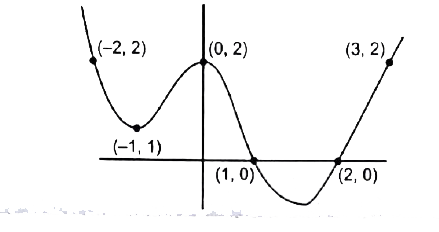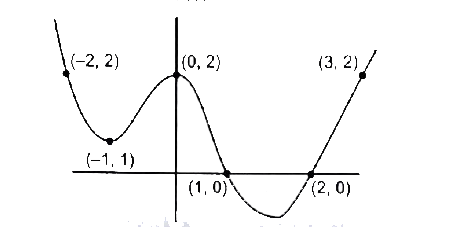Let Pn(ix)=1+2x+3x2+............+(n+1)xn be a polynomial such that n is even.The number of real roots of Pn(x)=0 is
The correct Answer is:0
To solve the problem, we need to analyze the polynomial Pn(x)=1+2x+3x2+…+(n+1)xn where n is even, and determine the number of real roots of the equation Pn(x)=0.
1. Understanding the Polynomial:
The polynomial is given as:
Pn(x)=1+2x+3x2+…+(n+1)xn
where n is an even integer.
2. Evaluating at Specific Points:
- First, let's evaluate Pn(0):
Pn(0)=1
- This indicates that at x=0, the polynomial is positive.
3. Behavior as x→∞:
- As x approaches infinity, the leading term (n+1)xn dominates, and since n is even, Pn(x)→+∞.
4. Behavior as x→−∞:
- As x approaches negative infinity, the leading term (n+1)xn will also dominate. Since n is even, Pn(x)→+∞ again.
5. Finding Critical Points:
- To find the critical points, we can compute the derivative P′n(x):
P′n(x)=2+3⋅2x+4⋅3x2+…+(n+1)nxn−1
- This derivative is a polynomial of degree n−1 and since n is even, n−1 is odd. Therefore, P′n(x) has at least one real root.
6. Analyzing the Sign of the Derivative:
- Since Pn(0)=1>0 and Pn(x)→+∞ as x→±∞, the polynomial must have a minimum point where it could potentially cross the x-axis.
7. Checking for Roots:
- However, since Pn(x) is continuous and starts from a positive value at x=0 and goes to positive infinity in both directions, we need to check if it can dip below zero.
- For x<0, as x decreases, the terms (n+1)xn and others will still contribute positively due to the even power of x.
8. Conclusion:
- Since Pn(x) does not change sign (it remains positive for all x), we conclude that there are no real roots for the equation Pn(x)=0.
Thus, the number of real roots of Pn(x)=0 is 0.
The polynomial is given as:
Pn(x)=1+2x+3x2+…+(n+1)xn
where n is an even integer.
- First, let's evaluate Pn(0):
Pn(0)=1
- This indicates that at x=0, the polynomial is positive.
- As x approaches infinity, the leading term (n+1)xn dominates, and since n is even, Pn(x)→+∞.
- As x approaches negative infinity, the leading term (n+1)xn will also dominate. Since n is even, Pn(x)→+∞ again.
- To find the critical points, we can compute the derivative P′n(x):
P′n(x)=2+3⋅2x+4⋅3x2+…+(n+1)nxn−1
- This derivative is a polynomial of degree n−1 and since n is even, n−1 is odd. Therefore, P′n(x) has at least one real root.
- Since Pn(0)=1>0 and Pn(x)→+∞ as x→±∞, the polynomial must have a minimum point where it could potentially cross the x-axis.
- However, since Pn(x) is continuous and starts from a positive value at x=0 and goes to positive infinity in both directions, we need to check if it can dip below zero.
- For x<0, as x decreases, the terms (n+1)xn and others will still contribute positively due to the even power of x.
- Since Pn(x) does not change sign (it remains positive for all x), we conclude that there are no real roots for the equation Pn(x)=0.
Topper's Solved these Questions
- MISCELLANEOUS EQUATIONS AND INEQUATIONS BOOK - OBJECTIVE RD SHARMA ENGLISHCHAPTER - MISCELLANEOUS EQUATIONS AND INEQUATIONS EXERCISE - Exercise
30 Videos
- MEASURES OF CENTRAL TENDENCYBOOK - OBJECTIVE RD SHARMA ENGLISHCHAPTER - MEASURES OF CENTRAL TENDENCYEXERCISE - Chapter Test
21 Videos
- PLANE AND STRAIGHT LINE IN SPACE BOOK - OBJECTIVE RD SHARMA ENGLISHCHAPTER - PLANE AND STRAIGHT LINE IN SPACE EXERCISE - Chapter Test
31 Videos
Similar Questions
Let Pn(x)=1+2x+3x2+............+(n+1)xn be a polynomial such that n is even.The number of real roots of Pn(x)=0 is
View SolutionThe maximum number of real roots of the equation x2n−1=0, is
View SolutionLet p(x) = a0+a1x+a2x2+.............+anxn be a non zero polynomial with integer coefficient . if p(√2+√3+√6)=0 , the smallest possible value of n . is
View SolutionIn the given figure graph of :
y=p(x)=xn+a1xn−1+a2xn−2+…..+an is given.

The minimum number of real roots of equation (p'(x))2+p(x)p''(x)=0 are:
View SolutionIn the given figure graph of :
y=p(x)=xn+a1xn−1+a2xn−2+…..+an is given.

The product of all imaginary roots of p(x)=0 is:
View SolutionLet n be a positive integer with f(n)=1!+2!+3!+.........+n!andp(x),Q(x) be polynomial in x such that f(n+2)=P(n)f(n+1)+Q(n)f(n) for all n≥, Then
View SolutionLet f(x)=(x+1)(x+2)(x+3)…..(x+100)andg(x)=f(x)f''(x)−f'(x)2. Let n be the numbers of real roots of g(x)=0, then:
View SolutionLet Pn(u) be a polynomial is u of degree n. Then, for every positive integern, sin2nx is expressible is
View SolutionIf the polynomial equation anxn+an−1xn−1+an−2xn−2+.......+a0=0,n being a positive integer, has two different real roots a and b. then between a and b the equation nanxn−1+(n−1)an−1xn−2+.......+a1=0 has
View SolutionIf a is defined by f (x)=a0xn+a1xn−2+a2xn−2+...+an−1x+an where n is a non negative integer and a0,a1,a2,…….,an are real numbers and a0≠0, then f is called a polynomial function of degree n. For polynomials we can define the following theorem
(i) Remainder theorem: Let p(x) be any polynomial of degree greater than or equal to one and 'a' be a real number. if p(x) is divided by (x-a), then the remainder is equal to p(a).
(ii) Factor theorem : Let p(x) be a polynomial of degree greater than or equal to 1 and 'a' be a real number such that p(a) = 0, then (x-a) is a factor of p(x). Conversely, if (x-a) is a factor of p(x). then p(a)=0.
The number of real roots of the equation, (x−1)2+(x−2)2+(x−3)2=0 is
View Solution
